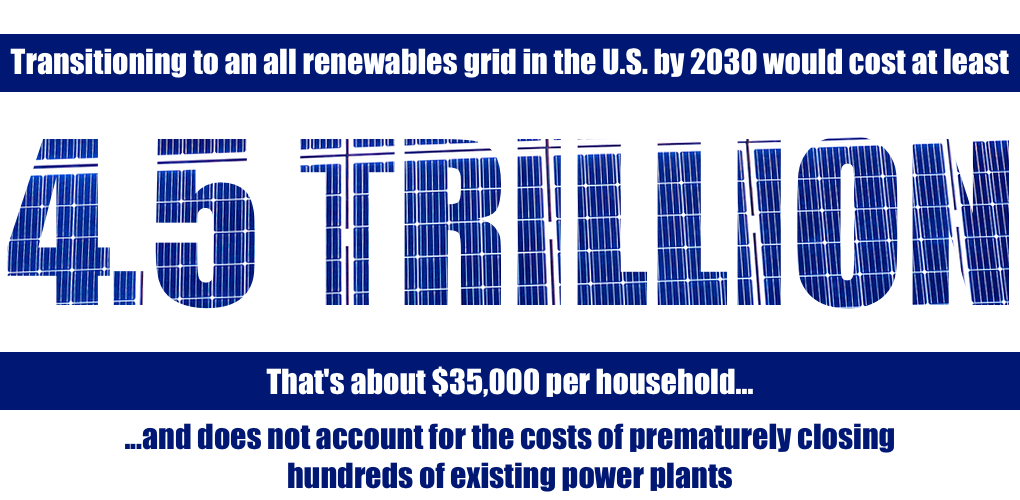
Trillions with a “T”
According to new analysis from Wood Mackenzie, transitioning to an all renewables grid in the U.S. by 2030 would cost roughly $4.5 trillion. Remarkably, that cost – estimated at about $35,000 per household – does not account for the costs of prematurely closing hundreds of existing power plants, the inevitable supply chain bottlenecks that would drive up the price of renewable technology, nor the cost of providing a just transition for the millions of Americans either directly employed by the fossil fuel and nuclear industries or supported by them.
If the whole premise seems absurd, recall that this is precisely the timeline and approach pushed by the Green New Dealers and several presidential contenders. This is merely an attempt at a partial accounting of that proposal. There’s nothing hypothetical about something already proposed by policymakers in our highest levels of government.
Uncharted Territory
Wood Mackenzie reminds us that nothing like a 100 percent renewables grid exists: “Today, no large and complex power system (PCPS) in the world operates with an average annual penetration of greater than 30% wind and solar… Beyond that point, operational and cost complexities progressively multiply, in large part due to the intermittent nature of renewables.”
That’s right. More renewables (intermittent power) produce a host of challenges that drive up the cost and complexity of delivering power and begin to pose serious threats to reliability. Texas and California already know that first hand. Germany and the UK provide further evidence of the challenges. Even moderate levels of renewable integration can produce excess power that must be curtailed while leaving huge gulfs in generation when the weather doesn’t cooperate that must be filled by backup power or energy storage – storage that doesn’t yet exist in any meaningful way. Higher renewable penetration, approaching 50%, begins to undue the very fabric of energy markets and the regulatory structure shaping them.
Tallying the Buildout
Wood Mackenzie estimates that about 1,600 GW of new wind and solar capacity would be needed to produce enough energy to replace the nation’s existing fossil fuel and nuclear generation. The grid would then need 900 GW of storage to ensure reliable power when consumers need it. There is currently just 5.5 GW of battery storage in operation or under construction in the entire world.
The battery supply chain to produce such a massive buildout does not exist. And, current lithium-ion technology is ill-suited for the longer duration back-up needs “critical to balancing seasonal swings in wind energy production or extended resource droughts stemming from major weather events.” The best grid-scale batteries can provide power for just four to six hours.
There too is the transmission buildout needed to move renewable generation to high-population centers. Here the authors assume a simple doubling of the high-voltage transmission capacity the U.S. already has, or the addition of another 200,000 miles of high-voltage transmission lines. Siting and building new transmission infrastructure is a herculean effort unto itself.
Adding up the wind and solar buildout, the addition of 900 GW of energy storage and a doubling of the nation’s high-voltage transmission capacity, the tab for this order comes in at $4.5 trillion dollars. It’s a figure so large, trying to place it into perspective is perhaps a fool’s errand. Wood Mackenzie compares it to the entire U.S. defense budget paid out every year for 10 to 20 years.
Other Costs and Questions
The authors write – in a near throwaway line – “Under RE100, cost reduction trends for W+S may reverse given the sheer magnitude of investment required across the supply chain.” May reverse is surely an understatement. The supply chain for the wind, solar and battery industries cannot in any way shape or form handle a buildout of this magnitude. The simple laws of supply and demand tell us that costs will rise. The manpower and skilled labor challenges are unaddressed. The raw material challenges are given barely a mention. These challenges, as awesome as they are, still pale in comparison to the potential public outcry over the per-household costs of such an effort and the industrialization of entire regions of the country with endless solar arrays, wind turbines and new transmission lines.
Decommissioning nearly 1,000 GW of existing coal, natural gas and nuclear power capacity and accounting for those stranded costs is a math problem in need of its own series of reports. Eliminating millions of jobs supported by these industries and even attempting to provide those workers and the regions of the country worst hit by such an effort with some kind of “just transition” is an exponentially complex and costly – if not impossible – exercise. The economic demolition imposed by such an effort is mind boggling. Just as difficult to comprehend is what precisely would be achieved.
If somehow, some way, all of these obstacles were overcome, if this boondoggle of biblical proportions were pursued in all the ferocity its supporters want, would the battle to curb global emissions be won? The answer is absolutely not.
Recall that the largest source of U.S. emissions isn’t even the power sector – it’s transportation. A sector of the economy untouched by this $4.5 trillion effort. Global emissions – despite the American sacrifice – would almost certainly overwhelm U.S. cuts, continuing to grow driven by mounting consumption in the industrializing world and a burgeoning, energy-hungry middle class. Can we expect Bangladesh, Vietnam or India to replicate our effort? The technical challenges, cost and social disruption alone would almost certainly make it a model no other nation would even consider touching, much less reproducing. The world needs U.S. energy leadership. This cannot be it.
- On July 2, 2019
